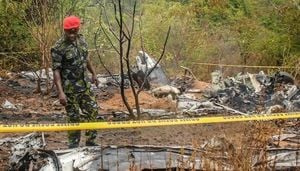The world stands on the precipice of a new and deeply uncertain nuclear era. Recent developments in South Asia, East Asia, and the Middle East, coupled with the unraveling of longstanding arms control agreements, have thrust the specter of nuclear conflict back into the global spotlight. Far from being a relic of Cold War anxieties, the threat of nuclear escalation is now a pressing reality, as nations modernize arsenals, pursue advanced delivery systems, and recalibrate doctrines in response to shifting power dynamics and regional rivalries.
In India, the transformation of military doctrine has been both rapid and profound. According to the Balochistan Think Tank Network, statements by Indian Air Force Chief Marshal AP Singh and Army Chief General Upendra Dwivedi reflect a shift toward a more offensive and assertive posture. India’s military modernization program has expanded well beyond traditional defense needs, evidenced by its status as the world’s second-largest importer of military equipment and its massive investment in indigenization. The country’s strategy now centers on escalation dominance—the ability to control the pace, intensity, and outcome of conflict, and to dictate terms at each rung of the escalation ladder.
Key to this strategy are multilayered missile and air defense systems, the canisterization of nuclear-capable missiles for rapid deployment, and the integration of cyber and space capabilities. These advancements are not just about deterrence; they are about ensuring that, should conflict erupt, India can end it on its own terms. The unveiling of the Cold Start doctrine in 2004, followed by the Joint Doctrine for Indian Armed Forces in 2017 and the Land Warfare Doctrine in 2018, laid the groundwork for this assertive approach.
Recent events have showcased India’s ambitions and the risks they entail. On September 25, 2025, the Indian Ministry of Defense announced the successful flight test of the rail-based Agni-Prime intermediate-range ballistic missile (MRBM)—the nation’s first railway-based ballistic missile, tested under a full operational scenario. As the Ministry noted, a rail-based launcher offers significant advantages in deployment speed, maneuverability, and survivability, joining India to a select group of nations with such capabilities. This test is a clear marker of India’s intent to field more diverse and survivable weapon systems.
Just days later, in early October 2025, India conducted a massive joint exercise, also named Cold Start, involving the Army, Navy, and Air Force. The drill, described by officials as the largest since the May 2025 India-Pakistan conflict, focused on testing drones and counter-drone systems—an acknowledgment of the changing nature of warfare and the importance of technological edge.
But India’s pursuit of escalation dominance has not gone uncontested. The four-day conflict with Pakistan in May 2025 highlighted both the strengths and limitations of this doctrine. After a strike inside Pakistan, India quickly claimed success for Operation Sindoor, touting its military prowess and technological progress. Diplomatically, New Delhi anticipated international backing, hoping to bolster its regional and global standing. Yet, on the battlefield, the story was more complicated. Pakistan’s robust retaliation reportedly resulted in the loss of six Indian jets and significant damage to key military installations, including some of India’s most expensive defense systems. As BTTN analysts Sher Ali Kakar and Atta Ullah observed, "India has been unable to achieve the desired outcomes from the conflicts it has initiated many times over the past two decades."
Internationally, the conflict’s resolution raised further questions about India’s autonomy in security matters. Former U.S. President Donald Trump claimed credit for brokering the ceasefire, asserting that his threat of "extremely high tariffs" was instrumental in ending hostilities. This episode has cast doubt on India’s long-held policy of strategic autonomy and its resistance to third-party involvement in the Kashmir dispute.
India’s military ambitions are also driving regional anxieties. Reports indicate that New Delhi is developing missiles capable of carrying bunker-buster warheads, heightening fears in Pakistan that such capabilities could cross nuclear thresholds and provoke a catastrophic response. These developments, combined with the expansion of India’s nuclear arsenal in terms of warheads, missiles, and fissile material, are seen by many as detrimental to regional peace and stability. Pakistan, for its part, has doubled down on its policy of full-spectrum deterrence, aiming to counter Indian moves at every level of the escalation ladder.
Against this backdrop, the broader global nuclear landscape is undergoing a dramatic transformation. As reported by Repubblica and the Stockholm International Peace Research Institute (SIPRI), China has unveiled its complete nuclear triad and now possesses at least 600 nuclear warheads—a number projected to rise to 1,500 by 2035, potentially rivaling the U.S. and Russian arsenals. At a September 2025 military parade marking the 80th anniversary of victory in World War II, Beijing showcased its growing strategic capabilities, signaling a new era of multipolar nuclear competition.
Russia, too, has tightened its nuclear doctrine and repeatedly brandished nuclear threats since its invasion of Ukraine. The termination of the Intermediate-Range Nuclear Forces Treaty (INF) and the Open Skies Treaty, along with the impending expiration of the New START Treaty in February 2026, have left the arms control architecture in tatters. Although there is talk of a one-year extension, the prospects for a successor agreement remain deeply uncertain.
Meanwhile, more countries are contemplating the nuclear option. On September 17, 2025, Saudi Arabia and Pakistan signed a defense agreement with a mutual assistance clause, signaling a shift in Middle Eastern power structures and reflecting doubts about the reliability of U.S. security guarantees. Even longtime U.S. allies such as Japan, South Korea, and some European states are openly considering developing their own nuclear capabilities amid rising global uncertainties.
Rafael Grossi, Director General of the International Atomic Energy Agency, recently warned that the world could soon see twenty to twenty-five nuclear-armed states. The risks are obvious: as the number of nuclear actors grows, so does the potential for irrational behavior, misjudgments, misunderstandings, technical accidents, and uncontrolled escalation. The complexity of deterrence increases exponentially, while the prospects for binding arms control agreements diminish.
Efforts to revive disarmament and arms control are urgently needed. The upcoming Nuclear Non-Proliferation Treaty (NPT) review conference in 2026 represents a critical opportunity to strengthen non-proliferation norms and renew commitments to risk reduction. The international community must also address emerging threats from artificial intelligence, hypersonic weapons, and the militarization of cyberspace and outer space. The United Nations, though indispensable, requires greater financial, personnel, and structural support to fulfill its role in non-proliferation and crisis management.
In the end, the path away from nuclear catastrophe lies in cooperation, transparency, and the political will to rebuild trust. The lessons of recent conflicts and the warnings of experts are clear: without renewed commitment to arms control and confidence-building measures, the world risks sleepwalking into a far more dangerous nuclear age.




